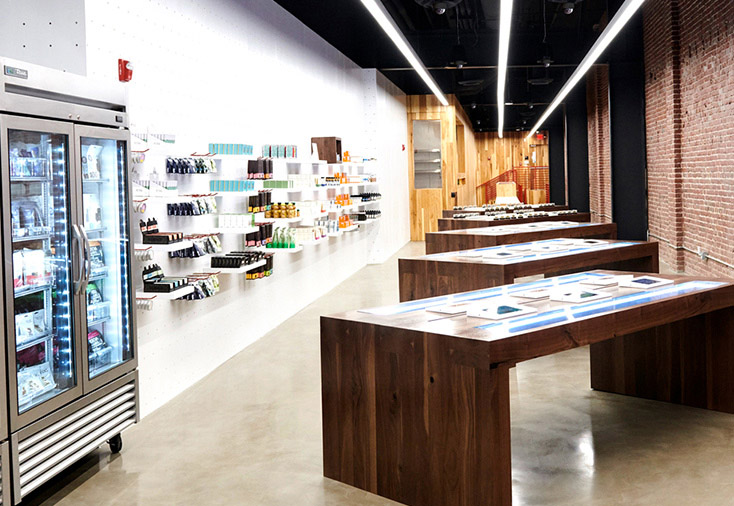Retail & Cannabis – Getting the Green Light?
Grassroots Cannabis. Green Growth Brands. Green Thumb Industries. Canopy. Cresco Labs. MedMen. There are more than a few cannabis-focused companies/retailers making headlines this year. Despite the federal government’s “yellow-light”, thirty states have given medicinal cannabis the green one.
Last week, three leading companies in the Cannabis Industry, including Grassroots Cannabis, Cresco Labs, and Brightfield Group gathered in their home of Chicago to discuss the future of cannabis retail. The panelists were Jourdan Kurtz of Cresco Labs, Steven Weisman of Grassroots Cannabis, Bethany Gomez of the Brightfield Group, and David Marcotte of Kantar Consulting. Our partner David Weiss moderated the panel.
Here are ten things we heard from the experts:
1) The potential market for cannabis products is still largely untapped. In Colorado, where recreational use was legalized in 2012 (and storefronts first opened in 2014), one-in-five adults have purchased a cannabis product. That compares to two-in three who have purchased alcohol.
2) Although we use the terms medicinal and recreational, these category names are misleading. Consumers generally use cannabis products as part of a wellness regime, which incorporates both legal licenses. Consumers want similar benefits as they seek in food or beauty products.
3) Current dispensaries are defensible retail propositions because of the limited number of licenses available. Currently, the next edge to “win” is location. Stopping at the nearest dispensary is the deciding factor for a consumer. But customer service – mainly, providing education in a setting where consumers are not intimidated or turned off by the atmosphere – is the other main factor in where a consumer shops.
4) Consumers don’t understand cannabis products, and so the number one service a dispensary can provide is education. As the panelists noted, getting a note from a physician isn’t like getting a prescription that specifies a pharmaceutical and dose. One panelist compared this to being instructed to “go into a CVS and buy some medicine.” Consumers don’t yet understand what they are looking for. First trips into dispensaries may last as long as thirty minutes in order to be educated by a “budtender.” Subsequent trips may be only 2-3 minutes long.
5) Although the term budtender brings to mind a hipster at a pub featuring craft brews, or Fast Times’ Spicoli, it should also bring to mind pharmacists… or beauticians. The environments of dispensaries are incredibly disparate, but most can currently aspire to be a cross between a beauty counter and a pharmacy.
6) Cannabis companies are cash-strapped. Banks are reticent to provide funding due to the current federal legislation. Therefore, reverse-engineering the registered location of the company – often to Canada – allows companies to trade on the Canadian Stock Market to raise funds. Green Thumb Industries issued stock in June, and its value has grown 3x since then. Major investments are also fueling the growth of select companies; Green Growth Brands has raised $65 million from private investors (including the Schottenstein family – investors in American Eagle Outfitters, Stone Cold Creamery and DSW.) Steve Weisman of Grassroots Cannabis and Windy City Cannabis – which operate a fully vertical branded product and retail business with 22 licenses – bootstrapped his company. But this model is becoming increasingly difficult.
7) It’s obvious that politics will play a part in the growth of the industry. Less obvious is the resulting impact on industry consolidation. There are few beer, wine and liquor superstores that cross multiple states. Of the 30 states that have legalized medical use of cannabis products, the companies with the largest reach are in only ten states today. You need a state-issued license to set up shop, and various laws may limit these to larger corporations.
8) Currently, supply is restricted to in-state growing facilities. Local politicians will likely keep these laws in place to maintain jobs. As the panelists pointed out – there is no reason to keep a growing facility in New York if you can grow your supply in an environment where you don’t need greenhouses. Yet all politics are local, and the jobs that are being created are real.
9) Following the law of unintended consequences, an in-state supply chain hampers brand growth on the product side. Each brand needs access to the cannabis suppliers in order to manufacture products, and this complicates the consistency of product, even if packaging remains the same. .
10) The dispensary of today will not be the only retail outlet of tomorrow. Models such as home delivery, multi-level-marketing, vending machines, and subscription services are all in the works. In other words, Grubhub, Farmer’s Fridge, Tupperware, and Stitchfix are all potential analogs. And that’s before the potential day when Walgreens, CVS, Target, or a grocery chain begins sales.

No Comments